Economic surprises and commodity futures returns #
Get packages and JPMaQS data #
Import and setup #
This notebook uses standard packages from the Python data science stack, plus the specialised
macrosynergy
package, which streamlines workflows in two key areas:
-
JPMaQS data download : Simplifies access to macro-quantamental indicators via the JPMorgan DataQuery REST API, handling formatting and filtering with minimal code.
-
Analysing quantamental signals : Accelerates analysis of macro trading signals, with built-in tools for normalisation, charting, and performance attribution.
For full documentation, see our Introduction to the Macrosynergy package or the Kaggle notebook . Technical reference documentation of the package is available on GitHub .
Installation:
pip install macrosynergy --upgrade
Credentials: Set your JPMorgan DataQuery credentials either directly in code or as environment variables:
DQ_CLIENT_ID: str = "your_client_id"
DQ_CLIENT_SECRET: str = "your_client_secret"
Corporate users behind firewalls can configure proxy settings via the PROXY = {} variable ( example here ).
# Constants and credentials
import os
REQUIRED_VERSION: str = "1.2.2"
DQ_CLIENT_ID: str = os.getenv("DQ_CLIENT_ID")
DQ_CLIENT_SECRET: str = os.getenv("DQ_CLIENT_SECRET")
PROXY = {} # Configure if behind corporate firewall
START_DATE: str = "1990-01-01"
import macrosynergy as msy
msy.check_package_version(required_version=REQUIRED_VERSION)
# If version check fails: pip install macrosynergy --upgrade
if not DQ_CLIENT_ID or not DQ_CLIENT_SECRET:
raise ValueError(
"Missing DataQuery credentials. Please set DQ_CLIENT_ID and DQ_CLIENT_SECRET as environment variables or insert them directly in the notebook."
)
# Standard imports
import numpy as np
import pandas as pd
import matplotlib.pyplot as plt
import seaborn as sns
from typing import Dict, List, Tuple
import warnings
# Macrosynergy package
import macrosynergy.management as msm
import macrosynergy.panel as msp
import macrosynergy.pnl as msn
import macrosynergy.signal as mss
import macrosynergy.visuals as msv
from macrosynergy.download import JPMaQSDownload
We download macro-quantamental indicators from JPMaQS using the J.P. Morgan DataQuery API via the
macrosynergy
package.
DataQuery expressions follow the structure:
DB(JPMAQS,<cross_section>_<category>,<info>)
, where:
-
JPMAQS: the dataset name -
<cross_section>_<category>: the JPMaQS ticker (e.g.,USD_EQXR01XD) -
<info>: time series type
Common
<info>
attributes include:
-
value: latest available indicator value -
eop_lag: days since end of observation period -
mop_lag: days since mean observation period -
grade: real-time quality metric -
last_updated: timestamp of the last update for the time series
This notebook uses
value
and
eop_lag
attributes.
The
JPMaQSDownload
class takes a list of JPMaQS tickers (
<cross_section>_<category>
format) via
.download(tickers,
start_date,
metrics)
and handles the DataQuery expression construction, throttle limits, and parallel data requests automatically.
Data selection and download #
# Currency area groupings for macro analysis
cids_dmca: List[str] = [
"AUD", "CAD", "CHF", "EUR", "GBP",
"JPY", "NOK", "NZD", "SEK", "USD"
] # Developed market currency areas
cids_latm: List[str] = ["BRL", "COP", "CLP", "MXN", "PEN"] # Latin America
cids_emea: List[str] = ["CZK", "HUF", "ILS", "PLN", "RON", "RUB", "TRY", "ZAR"] # EMEA
cids_emas: List[str] = ["CNY", "IDR", "INR", "KRW", "MYR", "PHP", "SGD", "THB", "TWD"] # EM Asia
# Aggregate currency groupings
cids_dm: List[str] = cids_dmca
cids_em: List[str] = cids_latm + cids_emea + cids_emas
cids: List[str] = sorted(cids_dm + cids_em)
# Commodity-sensitive FX
cids_cofx: List[str] = ["AUD", "BRL", "CAD", "CLP", "NZD", "PEN", "RUB"]
# Commodity cross-sections by sector
cids_bams: List[str] = ["ALM", "CPR", "LED", "NIC", "TIN", "ZNC"] # Base metals
cids_prms: List[str] = ["PAL", "PLT"] # Precious industrial metals
cids_fuen: List[str] = ["BRT", "WTI", "HOL", "GSO"] # Energy
cids_gold: List[str] = ["GLD"] # Gold
cids_coms: List[str] = cids_bams + cids_prms + cids_fuen # Non-gold commodities
# Quantamental categories of interest
# Industrial production transformations
ip_monthly: List[str] = ["P3M3ML3AR", "P6M6ML6AR", "P1M1ML12_3MMA"]
ip_quarterly: List[str] = ["P1Q1QL1AR", "P2Q2QL2AR", "P1Q1QL4"]
# Generate all IP indicators (monthly + quarterly)
ips: List[str] = [
f"IP_SA_{transform}_ARMAS"
for transform in ip_monthly + ip_quarterly
]
# Confidence survey transformations
confidence_monthly: List[str] = [
"_3MMA",
"_D1M1ML1",
"_D3M3ML3",
"_D6M6ML6",
"_3MMA_D1M1ML12",
"_D1M1ML12",
]
confidence_quarterly: List[str] = ["_D1Q1QL1", "_D2Q2QL2", "_D1Q1QL4"]
confidence_transforms: List[str] = [""] + confidence_monthly + confidence_quarterly
# Manufacturing confidence (all transformations)
mcs: List[str] = [
f"MBCSCORE_SA{transformation}_ARMAS"
for transformation in confidence_transforms
]
# Construction confidence (all transformations)
ccs: List[str] = [
f"CBCSCORE_SA{transformation}_ARMAS"
for transformation in confidence_transforms
]
# Core analytical factors (primary signals)
main: List[str] = ips + mcs + ccs
# Economic context indicators
econ: List[str] = [
"USDGDPWGT_SA_1YMA", # USD-weighted GDP trends (1-year)
"USDGDPWGT_SA_3YMA", # USD-weighted GDP trends (3-year)
"IVAWGT_SA_1YMA", # Investment value-added weights
]
# Market context indicators
mark: List[str] = [
"COXR_VT10", # Commodity return, vol-targeted
"EQXR_NSA", # Equity index futures returns
"EQXR_VT10", # Equity index futures returns, vol-targeted
]
# Combine all categories
xcats: List[str] = main + econ + mark
For further documentation of the indicators used see the Macro Quantamental Academy or JPMorgan Markets (password protected):
# Construct list of JPMaQS tickers for download
tickers: List[str] = []
# Core analytical indicators for all cross-sections
tickers += [f"{cid}_{xcat}" for cid in cids for xcat in main]
# Economic context indicators for all cross-sections
tickers += [f"{cid}_{xcat}" for cid in cids for xcat in econ]
# Market context indicators with specific rules
for xcat in mark:
if xcat.startswith("CO"): # Commodity returns: use commodity cross-sections
tickers += [f"{cid}_{xcat}" for cid in cids_coms + cids_gold]
elif xcat.startswith("EQ"): # Equity indicators: USD only (S&P 500)
tickers += [f"USD_{xcat}"]
else:
raise NotImplementedError(f"Unknown category for mark: {xcat}")
print(f"Maximum number of JPMaQS tickers to be downloaded is {len(tickers)}")
Maximum number of JPMaQS tickers to be downloaded is 943
# Download macro-quantamental indicators from JPMaQS via the DataQuery API
with JPMaQSDownload(
client_id=DQ_CLIENT_ID,
client_secret=DQ_CLIENT_SECRET,
proxy=PROXY
) as downloader:
df: pd.DataFrame = downloader.download(
tickers=tickers,
start_date=START_DATE,
metrics=["value", "eop_lag"],
suppress_warning=True,
show_progress=True,
report_time_taken=True,
get_catalogue=True,
)
Downloading the JPMAQS catalogue from DataQuery...
Downloaded JPMAQS catalogue with 23201 tickers.
Removed 788/1886 expressions that are not in the JPMaQS catalogue.
Downloading data from JPMaQS.
Timestamp UTC: 2025-06-26 14:05:41
Connection successful!
Requesting data: 100%|█████████████████████████████████████████████████████████████████| 55/55 [00:11<00:00, 4.93it/s]
Downloading data: 100%|████████████████████████████████████████████████████████████████| 55/55 [00:38<00:00, 1.44it/s]
Time taken to download data: 55.63 seconds.
# Preserve original downloaded data for debugging and comparison
dfx = df.copy()
dfx.info()
<class 'pandas.core.frame.DataFrame'>
RangeIndex: 3790405 entries, 0 to 3790404
Data columns (total 5 columns):
# Column Dtype
--- ------ -----
0 real_date datetime64[ns]
1 cid object
2 xcat object
3 value float64
4 eop_lag float64
dtypes: datetime64[ns](1), float64(2), object(2)
memory usage: 144.6+ MB
Availability #
# Availability of industry growth rates
xcatx = [xc for xc in main if xc[:3] == "IP_"]
cidx = cids
msm.check_availability(df, xcats=xcatx, cids=cidx, missing_recent=False)

# Availability of manufacturing survey scores
xcatx = [xc for xc in main if xc[:3] == "MBC"]
cidx = cids
msm.check_availability(df, xcats=xcatx, cids=cidx, missing_recent=False)

# Availability of construction survey scores
xcatx = [xc for xc in main if xc[:3] == "CBC"]
cidx = cids
msm.check_availability(dfx, xcats=xcatx, cids=cidx, missing_recent=False)

# Availability of market indicators for commodity strategy
xcatx = mark
cidx = cids_coms + ["GLD"] # Commodity cross-sections for strategy focus
msm.check_availability(dfx, xcats=xcatx, cids=cidx, missing_recent=False)

Feature engineering and checks #
Extract base tickers and their release frequencies #
# Step 1: Extract category tickers for all base indicators of surprises
base_xcats = [xcat for xcat in main if xcat.endswith("_ARMAS")]
# Step 2: Get availability counts for each country-indicator combination
xcatx: List[str] = base_xcats
cidx: List[str] = cids
availability_counts: pd.DataFrame = (
msm.reduce_df(dfx, xcats=xcatx, cids=cidx)
.groupby(["cid", "xcat"], as_index=False)["value"]
.count()
)
# Step 3: Extract observation period frequency from transformation codes
availability_counts["transformation"] = (
availability_counts["xcat"].str.split("_").str[2]
) # Cleaner extraction
availability_counts["frequency"] = availability_counts["transformation"].str[
2:3
] # 3rd character (M or Q)
# Step 4: Create country-indicator base identifiers (e.g., "AUD_IP")
availability_counts["country_indicator"] = (
availability_counts["cid"]
+ "_"
+ availability_counts["xcat"]
.str.split("_")
.str[0] # First part (IP, MBCSCORE, CBCSCORE)
)
# Step 5: Determine dominant frequency for each country-indicator combination
# (Quarterly takes precedence over monthly if both exist)
frequency_priority = {"Q": 2, "M": 1, None: 0} # Clear priority mapping
availability_counts["freq_priority"] = availability_counts["frequency"].map(
frequency_priority
)
# Step 6: Get the highest frequency for each country-indicator base
dominant_frequency = availability_counts.groupby("country_indicator", as_index=False)[
"freq_priority"
].max()
# Step 7: Convert back to frequency labels and create final mapping
priority_to_freq = {2: "Q", 1: "M", 0: "M"} # Default unknown to M
dominant_frequency["frequency"] = dominant_frequency["freq_priority"].map(
priority_to_freq
)
# Step 8: Create final frequency dictionary
quarterly_indicators = dominant_frequency[dominant_frequency["frequency"] == "Q"][
"country_indicator"
].tolist()
monthly_indicators = dominant_frequency[dominant_frequency["frequency"] == "M"][
"country_indicator"
].tolist()
dict_freq = {"Q": quarterly_indicators, "M": monthly_indicators}
print(f"Quarterly indicators: {len(dict_freq['Q'])}")
print(f"Monthly indicators: {len(dict_freq['M'])}")
Quarterly indicators: 12
Monthly indicators: 73
Normalize and annualize ARMA surprises #
# Generate ARMAS surprise indicators for strategy signals
xcatx = base_xcats
cidx = cids
dfxx = msm.reduce_df(dfx, xcats=xcatx, cids=cidx)
# Create sparse dataframe with information state changes
isc_obj = msm.InformationStateChanges.from_qdf(
df=dfxx,
norm=True, # normalizes changes by first release values
std="std",
halflife=36, # for volatility scaling only
min_periods=36,
score_by="level",
)
# Convert to dense quantamental dataframe
dfa = isc_obj.to_qdf(value_column="zscore", postfix="N", thresh=3)
dfa = dfa.dropna(subset=["value"])
basic_cols = ["real_date", "cid", "xcat", "value"]
dfx = msm.update_df(dfx, dfa[basic_cols])
# Convert surprise indicators to annualized units for strategy signals
xcatx = [xc + "N" for xc in base_xcats]
cidx = cids
dfa = msm.reduce_df(dfx, xcats=xcatx, cids=cidx)
dfa["cx"] = dfa["cid"] + "_" + dfa["xcat"].str.split("_").str[0]
filt_q = dfa["cx"].isin(dict_freq["Q"])
# Apply frequency-based scaling for annualization
dfa.loc[filt_q, "value"] *= np.sqrt(1/4) # Quarterly indicators
dfa.loc[~filt_q, "value"] *= np.sqrt(1/12) # Monthly indicators
# Add annualized suffix and clean up
dfa["xcat"] += "A"
basic_cols = ["real_date", "cid", "xcat", "value"]
dfx = msm.update_df(dfx, dfa[basic_cols])
Rename quarterly indicators to monthly equivalents for strategy consistency #
dict_repl = {
# Industrial production: quarterly → monthly equivalents
"IP_SA_P1Q1QL1AR": "IP_SA_P3M3ML3AR",
"IP_SA_P2Q2QL2AR": "IP_SA_P6M6ML6AR",
"IP_SA_P1Q1QL4": "IP_SA_P1M1ML12_3MMA",
# Manufacturing confidence: quarterly → monthly equivalents
"MBCSCORE_SA_D1Q1QL1": "MBCSCORE_SA_D3M3ML3",
"MBCSCORE_SA_D2Q2QL2": "MBCSCORE_SA_D6M6ML6",
"MBCSCORE_SA_D1Q1QL4": "MBCSCORE_SA_3MMA_D1M1ML12",
# Construction confidence: quarterly → monthly equivalents
"CBCSCORE_SA_D1Q1QL1": "CBCSCORE_SA_D3M3ML3",
"CBCSCORE_SA_D2Q2QL2": "CBCSCORE_SA_D6M6ML6",
"CBCSCORE_SA_D1Q1QL4": "CBCSCORE_SA_3MMA_D1M1ML12",
}
# Build complete replacement mapping in one step
models = ["_ARMAS", "_ARMASN", "_ARMASNA"]
complete_replacements = {
quarterly_indicator + suffix: monthly_indicator + suffix
for quarterly_indicator, monthly_indicator in dict_repl.items()
for suffix in models
}
# Transform quarterly indicators to monthly equivalents in single operation
dfx["xcat"] = dfx["xcat"].replace(complete_replacements)
dfx = dfx.sort_values(["cid", "xcat", "real_date"])
# Create user-friendly indicator names for visualization
indicator_labels = {
"IP_SA_P1M1ML12_3MMA_ARMAS": "Industry growth",
"MBCSCORE_SA_ARMAS": "Manufacturing confidence",
"CBCSCORE_SA_ARMAS": "Construction confidence",
}
# Generate availability chart for core economic indicators
xcatx: List[str] = list(indicator_labels.keys())
cidx: List[str] = cids
msm.check_availability(
dfx,
xcats=xcatx,
cids=cidx,
missing_recent=False,
title="Data availability by core economic indicator",
start_size=(18, 2),
#xcat_labels=indicator_labels
)

# Create indicator groups for strategy signal construction
def filter_by_indicator_type(indicators: List[str]) -> Dict[str, List[str]]:
"""Group indicators by economic report type."""
return {
'industrial': [ind for ind in indicators if ind.startswith("IP_")],
'manufacturing': [ind for ind in indicators if ind.startswith("MBC")],
'construction': [ind for ind in indicators if ind.startswith("CBC")]
}
# Annualized surprise indicators (available in dataset)
available_armas: List[str] = list(set(base_xcats) & set(dfx.xcat.unique())) # Remove quarterly (non-existing)
annualized_surprises: List[str] = [xc + "NA" for xc in available_armas]
surprise_groups: Dict[str, List[str]] = filter_by_indicator_type(annualized_surprises)
print(f"Surprise indicators: {len(annualized_surprises)}")
Surprise indicators: 17
Composite economic surprises (across transformations of base indicator) #
# Create linear composites of surprises and changes
cidx = cids
# Surprises configuration
dict_surprises: Dict[str, List[str]] = {
"IND": surprise_groups["industrial"],
"MBC": surprise_groups["manufacturing"],
"CBC": surprise_groups["construction"],
}
composite_dfs = []
# Create surprise composites
for base, xcatx in dict_surprises.items():
with warnings.catch_warnings():
warnings.simplefilter("ignore", category=UserWarning)
composite_dfs.append(msp.linear_composite(dfx, xcats=xcatx, cids=cidx, new_xcat=f"{base}_ARMASNA"))
# Store in main dataframe
dfa = pd.concat(composite_dfs, axis=0, ignore_index=True)
dfx = msm.update_df(dfx, dfa)
# Labels and list of composite factors
dict_csnames: Dict[str, List[str]] = {
"IND_ARMASNA": "Industrial production composite",
"MBC_ARMASNA": "Manufacturing business confidence composite",
"CBC_ARMASNA": "Construction business confidence composite",
}
comp_surprises = [key for key in dict_csnames.keys()]
# Inspect time-series of linear composite factors
xcatx = comp_surprises
cidx = ["USD"]
msp.view_timelines(
dfx,
xcats=xcatx,
cids=cidx,
ncol=3,
title="U.S.: composite economic surprises by type of indicator",
size=(16, 5),
xcat_labels=dict_csnames,
start="2000-01-01",
)

# Inspect time-series of specific linear composite factor
xcatx = ["MBC_ARMASNA"]
cidx = ["USD"]
msp.view_timelines(
dfx,
xcats=xcatx,
cids=cidx,
title="U.S. manufacturing confidence: composite of normalized and annualized surprises",
size=(16, 5),
start="2000-01-01",
)

Exponentially moving sums #
xcatx = comp_surprises
cidx = cids
hts = [3] # Half-lives
dfa = msm.reduce_df(dfx, xcats=xcatx, cids=cidx)
dfa["ticker"] = dfa["cid"] + "_" + dfa["xcat"]
p = dfa.pivot(index="real_date", columns="ticker", values="value")
store = []
for ht in hts:
proll = p.ewm(halflife=ht).sum()
proll.columns += f"_{ht}DXMS"
df_temp = proll.stack().to_frame("value").reset_index()
df_temp[["cid", "xcat"]] = df_temp["ticker"].str.split("_", n=1, expand=True)
store.append(df_temp[["cid", "xcat", "real_date", "value"]])
dfx = msm.update_df(dfx, pd.concat(store, axis=0, ignore_index=True))
# Generate lists of moving sum indicators
dict_csnames_3d = {
k + "_3DXMS": v + " 3-day half-life moving sum" for k, v in dict_csnames.items()
}
comp_surprises_3d = [key for key in dict_csnames_3d.keys()]
# Inspect time-series of linear composite factors
xcatx = comp_surprises_3d
cidx = ["USD"]
msp.view_timelines(
dfx,
xcats=xcatx,
cids=cidx,
ncol=3,
title="Composite economic surprises by type of indicator",
size=(16, 5),
xcat_labels=dict_csnames_3d,
start="2000-01-01",
)

xc = "IND"
xcatx = [xc + "_ARMASNA", xc + "_ARMASNA_3DXMS"]
cidx = ["USD"]
msp.view_timelines(
dfx,
xcats=xcatx,
cids=cidx,
start="2020-01-01",
end="2023-01-01",
title="Excerpt of U.S. industry growth composite surprises and exponential moving sums",
xcat_labels=[
"Normalized annualized surprise",
"Exponential moving sums with 3-day half life",
],
size=(16, 5),
)

Global composite surprises #
# Create global weighted composites using investment value-added weights
xcatx: List[str] = comp_surprises_3d
cidx: List[str] = cids
store: List[pd.DataFrame] = []
for xcat in xcatx:
dfr = msm.reduce_df(dfx, cids=cidx, xcats=[xcat, "IVAWGT_SA_1YMA"])
with warnings.catch_warnings():
warnings.simplefilter("ignore", category=UserWarning)
dfa = msp.linear_composite(
df=dfr,
xcats=xcat,
cids=cidx,
weights="IVAWGT_SA_1YMA",
new_cid="GLB",
complete_cids=False,
)
store.append(dfa)
dfx = msm.update_df(dfx, pd.concat(store, axis=0, ignore_index=True))
# Plot global composite signals by indicator type
cidx: List[str] = ["GLB"]
xcatx: List[str] = comp_surprises_3d
# Restructure data for plotting multiple series on single charts
dfa = msm.reduce_df(dfx, xcats=xcatx, cids=cidx)
dfa["ticker"] = dfa["cid"] + "_" + dfa["xcat"]
dfa["cid"] = dfa["ticker"].str[4:7] # Extract indicator type (IND, MBC, CBC)
dfa["xcat"] = dfa["ticker"].str[8:] # Extract signal type for comparison
# Labels and list of composite factors
dict_csnames_3d: Dict[str, List[str]] = {
"IND_ARMASNA_3DXMS": "Industrial production composite",
"MBC_ARMASNA_3DXMS": "Manufacturing business confidence composite",
"CBC_ARMASNA_3DXMS": "Construction business confidence composite",
}
msp.view_timelines(
dfx,
xcats=xcatx,
cids=cidx,
ncol=3,
title="Global composite economic surprises by type of indicator",
size=(16, 5),
xcat_labels=dict_csnames_3d,
start="2000-01-01",
)

Grand total global economic surprises #
# Create global aggregates across indicator categories (IND + MBC + CBC)
cidx: List[str] = ["GLB"]
dict_aggs: Dict[str, List[str]] = {
"ARMASNA_3DXMS": comp_surprises_3d, # 3-day surprise aggregate
}
store: List[pd.DataFrame] = []
for aggregate_name, component_xcats in dict_aggs.items():
store.append(msp.linear_composite(dfx, xcats=component_xcats, cids=cidx, new_xcat=aggregate_name))
dfx = msm.update_df(dfx, pd.concat(store, axis=0, ignore_index=True))
# Store list of global aggregate indicators
global_aggregates: List[str] = list(dict_aggs.keys())
xcat_labels = {
"ARMASNA_3DXMS": "Economic surprises, exponential moving sum with 5-day half life"
}
xcatx = list(xcat_labels.keys())
cidx = ["GLB"]
msp.view_timelines(
dfx,
xcats=xcatx,
cids=cidx,
title="Global aggregate economic surprises: average across indicator types",
xcat_labels=xcat_labels,
size=(16, 5),
start="2000-01-01",
)

Target returns and checks #
Vol-targeted contract returns #
# Industrial commodities
cidx = cids_coms
xcatx = ["COXR_VT10"]
dict_coms: Dict[str, List[str]] = {
"BRT": "Brent crude oil",
"WTI": "West Texas Intermediate crude oil",
"GSO": "Gasoline",
"HOL": "Heating oil",
"ALM": "Aluminum",
"CPR": "Copper",
"LED": "Lead",
"NIC": "Nickel",
"TIN": "Tin",
"ZNC": "Zinc",
"PAL": "Palladium",
"PLT": "Platinum",
"NGS": "Natural gas",
}
msp.view_timelines(
dfx,
xcats=xcatx,
cids=cidx,
cumsum=True,
title="Industrial commodities: cumulative vol-targeted futures returns since 2000",
title_fontsize=24,
cid_labels=dict_coms,
same_y=True,
size=(14, 6),
aspect=1.75,
single_chart=False,
start="2000-01-01",
)
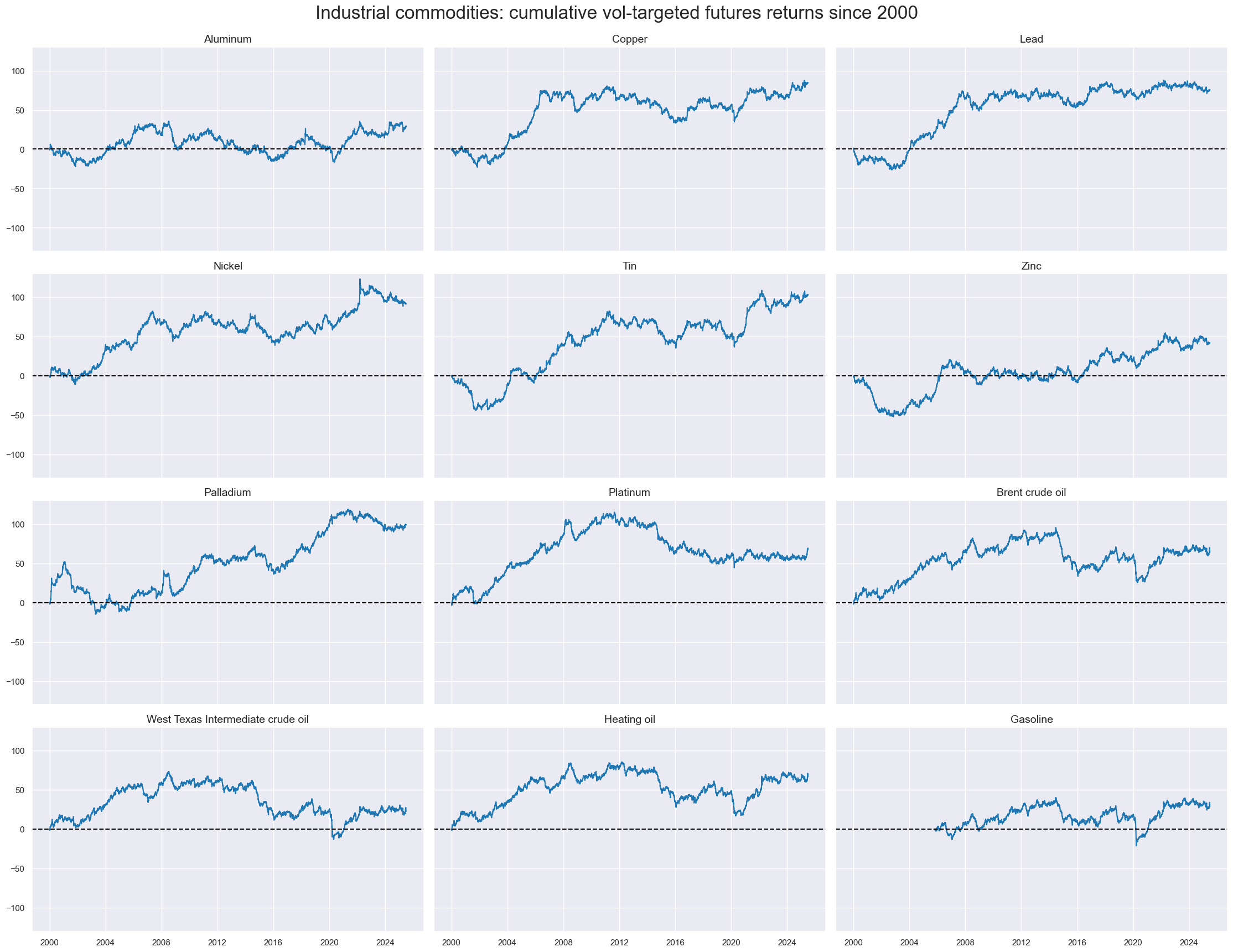
cidx = cids_coms
xcatx = ["COXR_VT10"]
msv.view_correlation(
df=dfx,
xcats=xcatx,
cids=cidx,
cluster=True,
freq="M",
title="Futures returns correlation across industrial commodities, monthly averages, since 2000",
title_fontsize=18,
size=(16, 8),
start="2000-01-01",
)

Hedged vol-targeted contract returns #
store: List[str] = []
cidx = cids_coms
with warnings.catch_warnings():
warnings.simplefilter("ignore", category=UserWarning)
dfh = msp.return_beta(
dfx,
xcat="COXR_VT10",
cids=cidx,
benchmark_return="GLD_COXR_VT10",
oos=True,
min_obs=24,
max_obs=60,
hedged_returns=True,
# start="2000-01-01",
refreq="m",
hr_name="HvGLD",
)
dfh.xcat = dfh.xcat.cat.rename_categories({"COXR_VT10_HR": "COXR_BETAvGLD"})
dfx = msm.update_df(df=dfx, df_add=dfh, xcat_replace=True)
# Plot the betas
xcatx: List[str] = ["COXR_BETAvGLD"]
cidx = cids_coms
msv.timelines(
dfx,
xcats=xcatx,
cids=cidx,
start="2000-01-01",
ncol=6,
title="Industrial commodity future betas to gold futures returns",
title_fontsize=20,
cid_labels=dict_coms,
height=2,
aspect=1,
single_chart=False,
ax_hline=0,
)

# Plot hedged returns
xcatx: List[str] = ["COXR_VT10", "COXR_VT10_HvGLD",]
cidx = cids_coms
msp.view_timelines(
dfx,
xcats=xcatx,
cids=cidx,
# start="2000-01-01",
cumsum=True,
title="Industrial commodities: cumulative vol-targeted futures returns",
title_fontsize=24,
cid_labels=dict_coms,
xcat_labels=["unhedged returns", "hedged returns"],
same_y=True,
size=(14, 6),
aspect=1.75,
single_chart=False,
start="2000-01-01",
)
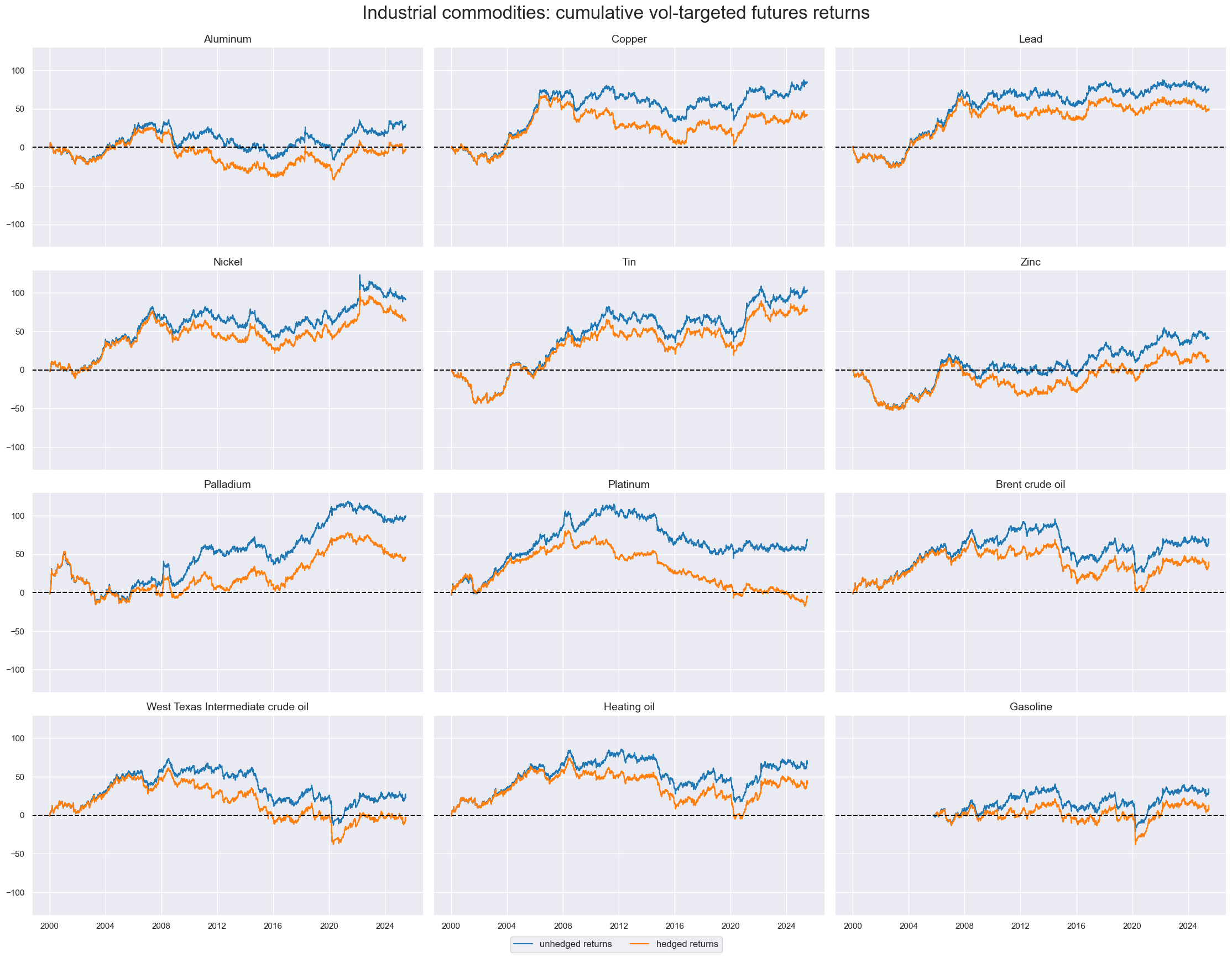
Commodity basket returns #
# Create basket against Gold
store = []
baskets: List[Tuple[str, List[str]]] = [("", cids_coms), ("BAMS", cids_bams), ("PRMS", cids_prms), ("FUEN", cids_fuen)]
targets = ["", "_HvGLD"]
for cat, cidx in baskets:
for target in targets:
xcat = f"COXR_VT10{target}"
dfa = msp.linear_composite(
df=msm.reduce_df(dfx, xcats=[xcat], cids=cidx),
xcats=xcat,
cids=cidx,
weights=None, # equal weights
new_cid="GLB",
complete_cids=False, # uses available contracts only
)
# Rename to basket of commodities
dfa["xcat"] = f"CO{cat:s}XR_VT10{target:s}"
store.append(dfa)
dfx = msm.update_df(dfx, pd.concat(store, axis=0, ignore_index=True))
# Plot basket returns
targets = ["", "_HvGLD"]
xcatx: List[str] = [f"COXR_VT10{target:s}" for target in targets]
cidx = ["GLB"]
msp.view_timelines(
dfx,
xcats=xcatx,
cids=cidx,
cumsum=True,
title="Industrial commodities basket: cumulative vol-targeted futures returns",
xcat_labels=[
"unhedged",
"hedged",
],
size=(16, 5),
start="2000-01-01",
)

Value checks #
Unhedged basket trading #
Specs and panel test #
dict_unhedged = {
"sig": "ARMASNA_3DXMS",
"targ": "COXR_VT10",
"cidx": ["GLB"],
"start": "2000-01-01",
"black": None,
"crr": None,
"srr": None,
"pnls": None,
}
dix = dict_unhedged
sig = dix["sig"]
targ = dix["targ"]
cidx = dix["cidx"]
start = dix["start"]
crx = msp.CategoryRelations(
dfx,
xcats=[sig, targ],
cids=cidx,
freq="D",
lag=1,
xcat_aggs=["last", "sum"],
start=start,
)
with warnings.catch_warnings():
warnings.simplefilter("ignore")
crx.reg_scatter(
labels=False,
coef_box="lower left",
separator=2013,
title="Global economic surprises and subsequent daily commodity basket returns, 2000-2025",
title_fontsize=16,
xlab="Global aggregated economic surprise, exponential moving average with 3-day half life, end-of day",
ylab="Industrials commodity basket returns in %, vol-targeted, next day",
size=(12, 7),
prob_est="map",
)

Accuracy and correlation check #
dix = dict_unhedged
sig = dix["sig"]
targ = dix["targ"]
cidx = dix["cidx"]
start = dix["start"]
srr = mss.SignalReturnRelations(
dfx,
cids=cidx,
sigs=sig,
rets=targ,
freqs="D",
start=start,
)
dix["srr"] = srr
dix = dict_unhedged
srr = dix["srr"]
display(srr.multiple_relations_table().astype("float").round(3).T)
| Return | COXR_VT10 |
|---|---|
| Signal | ARMASNA_3DXMS |
| Frequency | D |
| Aggregation | last |
| accuracy | 0.517 |
| bal_accuracy | 0.517 |
| pos_sigr | 0.501 |
| pos_retr | 0.527 |
| pos_prec | 0.545 |
| neg_prec | 0.490 |
| pearson | 0.048 |
| pearson_pval | 0.000 |
| kendall | 0.025 |
| kendall_pval | 0.002 |
| auc | 0.517 |
dix = dict_unhedged
srr = dix["srr"]
srr.accuracy_bars(
type="years",
title="Daily accuracy for vol-targeted return sign prediction across calendar years",
size=(15, 5),
)
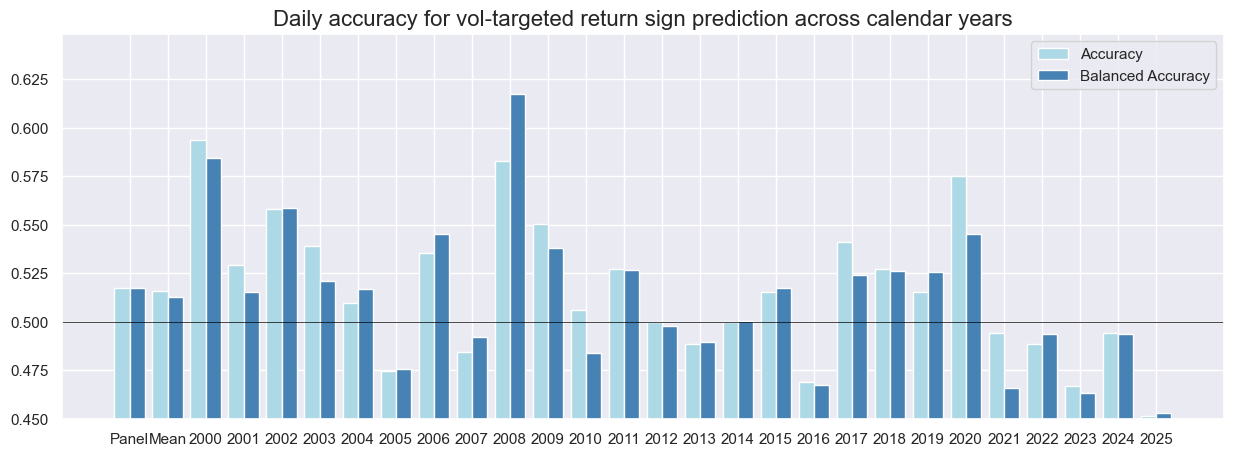
Naive PnL #
dix = dict_unhedged
sig = dix["sig"]
targ = dix["targ"]
cidx = dix["cidx"]
start = dix["start"]
naive_pnl = msn.NaivePnL(
dfx,
ret=targ,
sigs=[sig],
cids=cidx,
start=start,
bms=["USD_EQXR_NSA"],
)
for long_bias in (0, 1):
naive_pnl.make_pnl(
sig,
sig_neg=False,
sig_op="zn_score_cs",
sig_add=long_bias,
thresh=2,
rebal_freq="daily",
vol_scale=None,
rebal_slip=0,
pnl_name=sig + f"_PZN{long_bias:d}",
)
naive_pnl.make_long_pnl(vol_scale=None, label="Long only")
dix["pnls"] = naive_pnl
dix = dict_unhedged
naive_pnl = dix["pnls"]
sig = dix["sig"]
pnl_labels = {
f"{sig:s}_PZN0": "Surprise-based strategy without directional bias",
f"{sig:s}_PZN1": "Surprise-based strategy with long bias",
"Long only": "Long only",
}
pnls = list(pnl_labels.keys())
naive_pnl.plot_pnls(
pnl_cats=pnls,
pnl_cids=["ALL"],
start=start,
title="Naive PnL of surprise-based trading so single industrial commodity futures basket",
title_fontsize=16,
xcat_labels=pnl_labels,
figsize=(14, 7),
)
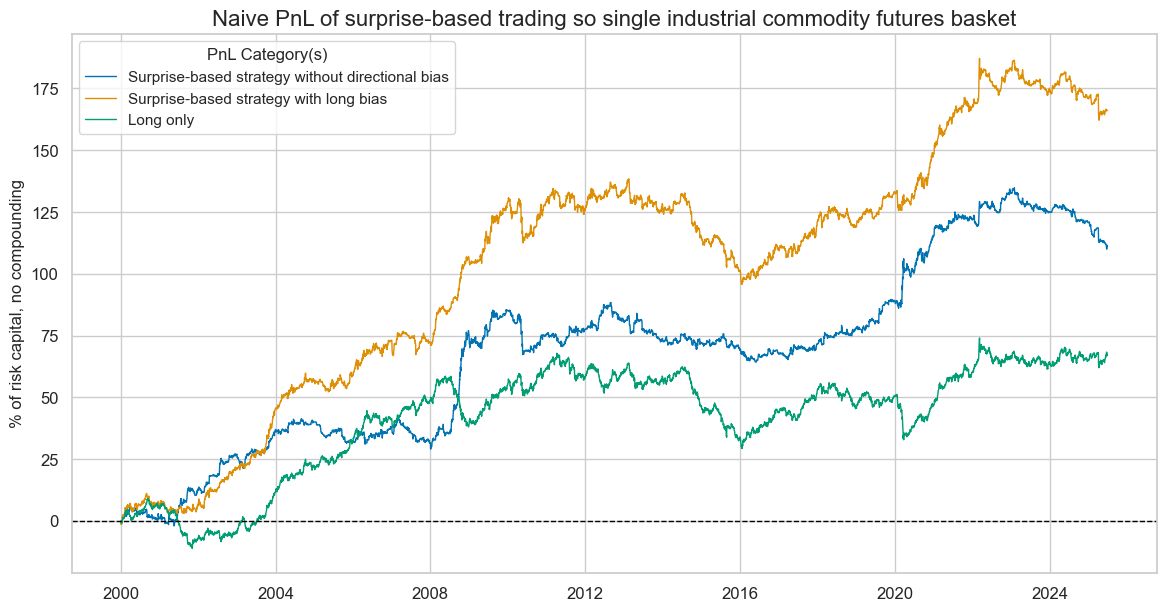
dix = dict_unhedged
naive_pnl = dix["pnls"]
display(naive_pnl.evaluate_pnls())
naive_pnl.signal_heatmap(
pnl_name="ARMASNA_3DXMS_PZN1",
freq="m",
)
| xcat | ARMASNA_3DXMS_PZN0 | ARMASNA_3DXMS_PZN1 | Long only |
|---|---|---|---|
| Return % | 4.37104 | 6.523791 | 2.635708 |
| St. Dev. % | 7.427 | 8.913999 | 7.191436 |
| Sharpe Ratio | 0.588534 | 0.731859 | 0.366506 |
| Sortino Ratio | 0.882928 | 1.035662 | 0.507064 |
| Max 21-Day Draw % | -15.375868 | -17.217568 | -14.302399 |
| Max 6-Month Draw % | -16.807392 | -20.328708 | -20.143069 |
| Peak to Trough Draw % | -24.853876 | -42.617399 | -38.519882 |
| Top 5% Monthly PnL Share | 0.938577 | 0.610671 | 1.030927 |
| USD_EQXR_NSA correl | -0.075653 | 0.145845 | 0.286987 |
| Traded Months | 306 | 306 | 306 |

Hedged basket trading #
Specs and panel test #
dict_hedged = {
"sig": "ARMASNA_3DXMS",
"targ": "COXR_VT10_HvGLD",
"cidx": ["GLB"],
"start": "2000-01-01",
"black": None,
"crr": None,
"srr": None,
"pnls": None,
}
dix = dict_hedged
sig = dix["sig"]
targ = dix["targ"]
cidx = dix["cidx"]
start = dix["start"]
crx = msp.CategoryRelations(
dfx,
xcats=[sig, targ],
cids=cidx,
freq="D",
lag=1,
xcat_aggs=["last", "sum"],
start=start,
)
with warnings.catch_warnings():
warnings.simplefilter("ignore")
crx.reg_scatter(
labels=False,
coef_box="lower left",
separator=2013,
xlab="Global aggregated economic surprise, exponential moving average with 3-day half life, end-of day",
ylab="Commodity basket returns in %, vol-targeted, hedged, next day",
title="Global economic surprises and subsequent hedged daily commodity basket returns, 2000-2025",
title_fontsize=16,
size=(12, 7),
prob_est="map",
)
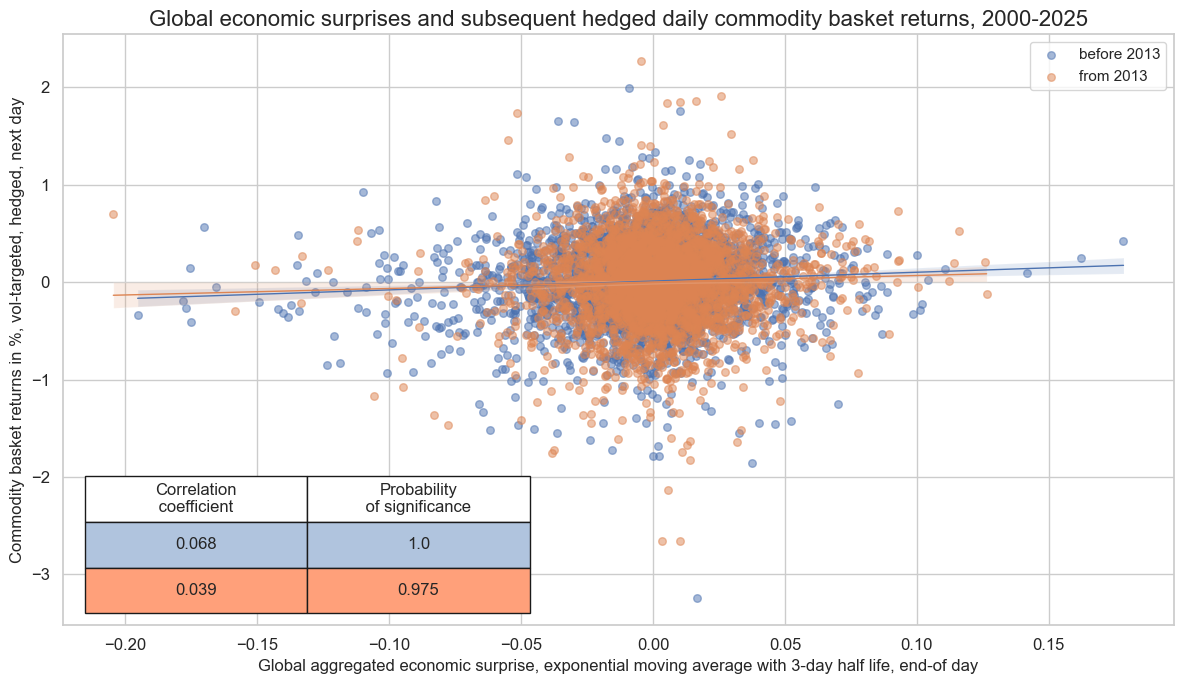
Accuracy and correlation check #
dix = dict_hedged
sig = dix["sig"]
targ = dix["targ"]
cidx = dix["cidx"]
start = dix["start"]
srr = mss.SignalReturnRelations(
dfx,
cids=cidx,
sigs=sig,
rets=targ,
freqs="D",
start=start,
)
dix["srr"] = srr
dix = dict_hedged
srr = dix["srr"]
display(srr.multiple_relations_table().astype("float").round(3).T)
| Return | COXR_VT10_HvGLD |
|---|---|
| Signal | ARMASNA_3DXMS |
| Frequency | D |
| Aggregation | last |
| accuracy | 0.508 |
| bal_accuracy | 0.508 |
| pos_sigr | 0.501 |
| pos_retr | 0.525 |
| pos_prec | 0.533 |
| neg_prec | 0.483 |
| pearson | 0.054 |
| pearson_pval | 0.000 |
| kendall | 0.026 |
| kendall_pval | 0.002 |
| auc | 0.508 |
Naive PnL #
dix = dict_hedged
sig = dix["sig"]
targ = dix["targ"]
cidx = dix["cidx"]
start = dix["start"]
naive_pnl = msn.NaivePnL(
dfx,
ret=targ,
sigs=[sig],
cids=cidx,
start=start,
bms=["USD_EQXR_NSA"],
)
for long_bias in (0, 1):
naive_pnl.make_pnl(
sig,
sig_neg=False,
sig_op="zn_score_cs",
sig_add=long_bias,
thresh=2,
rebal_freq="daily",
vol_scale=None,
rebal_slip=0,
pnl_name=sig + f"_PZN{long_bias:d}",
)
naive_pnl.make_long_pnl(vol_scale=None, label="Long only")
dix["pnls"] = naive_pnl
dix = dict_hedged
naive_pnl = dix["pnls"]
sig = dix["sig"]
pnl_labels = {
f"{sig:s}_PZN0": "Surprise-based strategy without directional bias",
f"{sig:s}_PZN1": "Surprise-based strategy with long bias",
"Long only": "Long only",
}
pnls = list(pnl_labels.keys())
naive_pnl.plot_pnls(
pnl_cats=pnls,
pnl_cids=["ALL"],
start=start,
title="Naive PnL of surprise-based trading of single hedged industrial commodity futures basket",
title_fontsize=16,
xcat_labels=pnl_labels,
figsize=(14, 7),
)

dix = dict_hedged
naive_pnl = dix["pnls"]
display(naive_pnl.evaluate_pnls())
naive_pnl.signal_heatmap(
pnl_name="ARMASNA_3DXMS_PZN0",
freq="m",
)
| xcat | ARMASNA_3DXMS_PZN0 | ARMASNA_3DXMS_PZN1 | Long only |
|---|---|---|---|
| Return % | 4.792582 | 5.706744 | 1.268342 |
| St. Dev. % | 7.02999 | 8.322689 | 6.660833 |
| Sharpe Ratio | 0.681734 | 0.685685 | 0.190418 |
| Sortino Ratio | 1.046182 | 0.967819 | 0.26069 |
| Max 21-Day Draw % | -15.713679 | -19.359406 | -13.492343 |
| Max 6-Month Draw % | -17.007099 | -19.048991 | -19.006064 |
| Peak to Trough Draw % | -23.609668 | -33.977972 | -40.533251 |
| Top 5% Monthly PnL Share | 0.846206 | 0.683088 | 2.084462 |
| USD_EQXR_NSA correl | -0.084836 | 0.152752 | 0.307985 |
| Traded Months | 306 | 306 | 306 |
